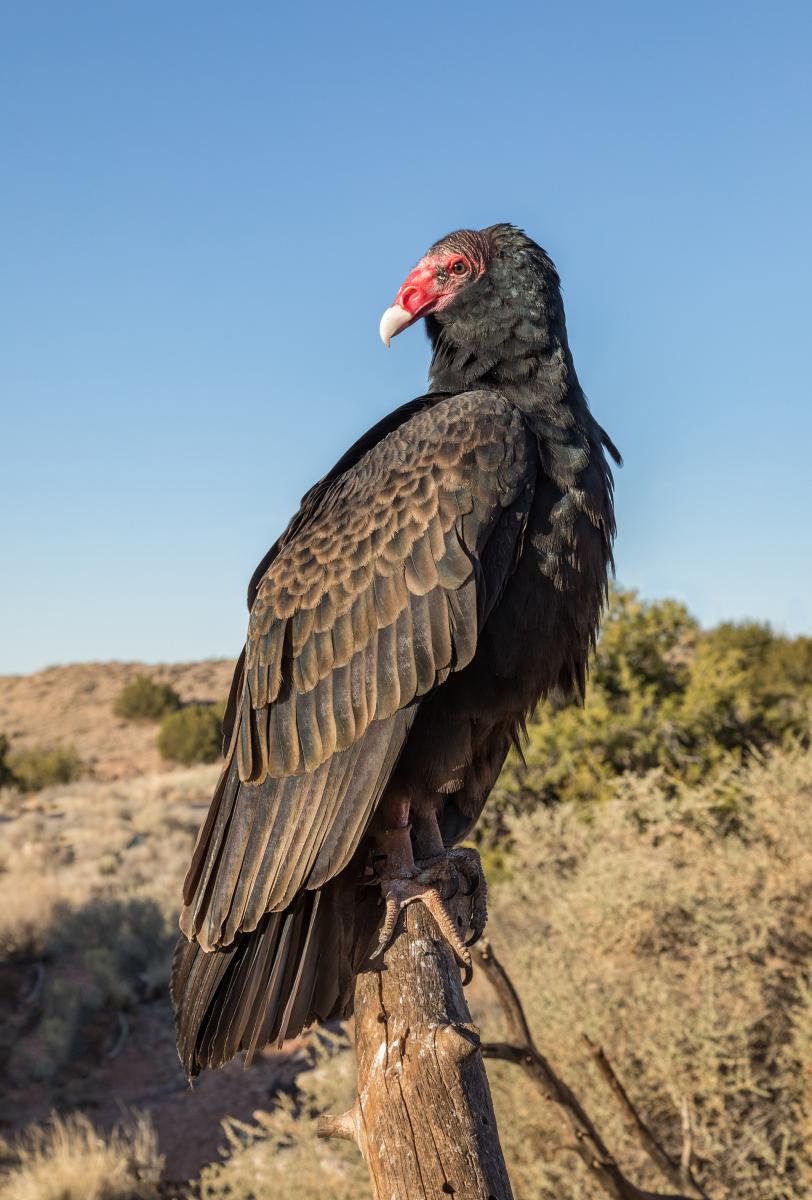Beauty the turkey vulture’s cameo in the film Copshop sheds light on the raptor’s importance. Photograph courtesy of Copshop.
THEY EAT THE DECAYING FLESH of dead animals and vomit as a defense mechanism. The wrinkled pink skin on their heads makes them look like they just bobbed for apples in a vat of acid. What’s not to love about turkey vultures?
With fingerlike feathers and a wingspan stretching up to six feet, they soar for long periods without a single wingbeat. Their keen sense of smell can detect decomposing carcasses even as they fly hundreds of feet in the air, says Stewart Liley, chief of the Wildlife Management Division for the New Mexico Department of Game & Fish.
These raptors, which migrate to New Mexico from late spring to early fall, help prevent the spread of disease by eating a corpse before it can serve as a host to bacteria. Potent stomach acid allows them to eat a rotten meal without getting sick, while their featherless heads make for easy cleanup.
Still not convinced of their lovable grossness? Turkey vultures cool off by urinating down their legs. When threatened on the ground, they puke up their last meal to make a quick, foul-smelling getaway.
“They’re a uniquely adapted animal for the role that they play in our world,” says Gail Garber, executive director of the conservation group Hawks Aloft. “They keep the planet clean.”

Turkey vultures can be found in New Mexico from April through September. Photograph by Larry Rimer.
Buzzard Meet
Here are three great places to spot turkey vultures in action.
Manzano Mountains
Hike three-quarters of a mile to HawkWatch International’s migration observation area off CR B066, near Capilla Peak in the Cibola National Forest. Open August 27 through November 5, the site houses five biologists who track the 5,000 to 7,000 raptors—including around 500 turkey vultures—as they make their way south for the winter. Best time: Second half of September.
Bandelier National Monument
Park at the monument’s visitor center to catch turkey vultures—about 20 normally roost in the area—soaring above the towering walls of Frijoles Canyon. Afternoons are best, when the canyon walls have warmed the surrounding air, creating the thermals these birds love to ride. Best time: Beginning of May through the end of September
Carlsbad Caverns National Park
Just south of the park’s iconic caves sits Rattlesnake Springs, a day-use site that’s been designated an “important bird area” by the Audubon Society. The springs act as an oasis in the desert, making it a great watering hole for migratory birds, including turkey vultures. Best time: Mid-April through mid-June.
 Beauty is the turkey vulture ambassador for Albuquerque-based Hawks Aloft. Photograph by Gail Garber.
Beauty is the turkey vulture ambassador for Albuquerque-based Hawks Aloft. Photograph by Gail Garber.
Movie Maven
Beauty the turkey vulture gets a star turn.
BEAUTY: NOT A BEAST. That’s the message borne by Beauty, the turkey vulture ambassador for Albuquerque-based Hawks Aloft, a conservation, avian research, education, and raptor rescue organization. The seven-year-old raptor travels the state (with her handlers, of course) educating people about why they should admire these birds of prey. “She’s hugely popular in the classroom,” says Gail Garber, Hawks Aloft’s executive director. “When they can see a bird like that up close and personal, it makes a huge difference in how they value that kind of species.”
That educational perspective was integral to Beauty’s recent star turn in the action thriller Cop Shop, which filmed in Albuquerque last year. (Its release date remains—ahem—up in the air.) Hawks Aloft permitted the cameo on the condition that Beauty’s inclusion would serve as a way to bring attention to the importance of vultures in the natural ecosystem.
Sadly, the natural ecosystem Beauty advocates for is not one she’s experienced. When she was a nestling, a well-meaning individual found her with a chest injury, but then kept her illegally until she was confiscated at age five and brought to Hawks Aloft. Being in human captivity caused irreversible brain damage, Garber explains. “She could never be a wild bird. She can never have babies of her own, but she’s an amazing ambassador for her wild cousins.”


